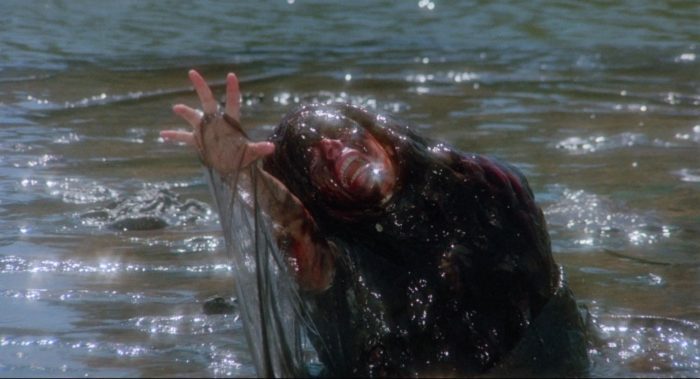Field Notes From A Nightmare is a new anthology from Dread Stone Press, a collection of 18 eco-horror stories from various authors. Eco-, or ecological, horror involves nature. Either by gaining some supernatural abilities or evolving beyond our understanding, the flora and fauna of our world are a treasure trove of horrific ideas just waiting to be brought to the page. It’s been used as a metaphor for radiation sickness (Matango or as it’s sometimes called Attack of the Mushroom People directed by Godzilla co-creator Ishirō Honda), explorations of evolution and xenobiology (Annihilation and the Southern Reach books the film is based on), or even direct references to the Bubonic plague. Zombies, such as the ones in 28 Days Later, could also be considered eco-horror as they are the result of viruses.
Each story is presented with an illustration by David Bowman; sharp pens with cross-hatching give off a dark fairytale quality. Each pair with their respective story quite well, drawing you in. (Pun not intended.) I’m going to geek out for a second because I’ve been doing a lot of reading lately and was excited to see some authors I enjoy as part of this. Eric Raglin’s collection Nightmare Yearnings was fantastic (and features a tale about the Great Garbage Patch), and Joanna Koch’s The Wingspan of Severed Hands was poetic and inspiring. This is a talented group! I believe everyone included has other work, so if one resonates with you I’d highly suggest seeking out more stories.
“So many will watch their children die first, and even that thought has never been enough to propel humanity into significant changes,” from Sara Tantlinger‘s “As Humans Burn Beneath Us,” the story that opens the anthology, sums up climate change perfectly and sets the tone for the rest of the book. The sheer apathy and refusal of many to commit to improving the planet we live on are some of the most depressing aspects of the current age. There is only so much I, as an individual, can do. The people causing the most destruction are so withdrawn from it they might as well be on Mars.
Earth sits and watches us deplete her resources, pollute land, sea, and sky until nature decides to fight back. In “Blame” by Carter Lappin, the protagonist is haunted by an oil spill, the memory of muck sticking to birds and killing fish. They block the pipes in their house, but it’s no use. The Earth is angry. Who can blame her? The destruction of our oceans from incidents like the one described here is awe-inspiring in magnitude. The sequence called “The Raft” in Creepshow 2 also features an organic oil-like creature that kills several teens going for a swim. In both, there is no “winning” against these beings. It’s just a matter of time ’til you join them in the depths.

Both Gordon B. White and Joanna Koch’s stories deal with the corruption of the human body via plants, the former “Dandelion Six,” a biological bomb to revitalize plant growth, and the latter mushrooms that seek darkness to propagate (“We Have Always Lived in the Soil”). Fungus is a common theme in eco-horror for a good reason; it’s both an extremely old and mysterious organism and therefore can be used in a multitude of ways, from the zombies in The Last of Us to the recent film The Spore.
Trees have also earned their revenge, and “Root Structure” from Eddie Generous involves the biggest and oldest root system in the world, the Sapientia silvam, which clocks in at over 100,000 years and still kicking. It was here first and will be here long after we’re dead and gone. (My little Canadian heart was also pleased this story involves both snowmobiles and hockey.)
“Los Angeles Is Sinking” from Gwen C. Katz touches on a potential apocalypse but also hits close to home with current events; the world is burning, people are dying, but there are still products to be sold and money to be made. Black Friday will soon be upon us once again. “Meat(™)” from Tim Hoelscher digs into this with commercialized cannibalism, even making direct reference to Soylent Green.
An interesting note is that the majority of Nightmare’s tales are at their core, about loneliness, our reactions to it, and how it affects each of us differently. It’s been a long two years and the after-effects will last lifetimes. Some have used quarantine to better their health or learn a hobby. Others turn inwards or isolate even more. “Concerning a Pond in Massachusetts” by Jonathan Louis Duckworth involves such a man, living alone and tending to a field of beans as strange, cosmic phenomena begin to disrupt his idyllic lifestyle.
It’s easy to get caught up in the doom and gloom and reality of our crumbling ecosystem with tales like these because some are not too far off from the truth. On the other hand, there are people who are pushing forward positive change right now. It’s this resilience that keeps us going, and I think that’s really the heart of Field Notes from a Nightmare. Working together and looking towards the future, even if things seem grim.
Field Notes from a Nightmare releases on November 16th. Dread Stone Press has a helpful list of content warnings on its website for the anthology. An ebook copy was provided for review purposes.


